TMEM164 is an acyltransferase that forms ferroptotic C20:4 ether phospholipids
- PMID: 36782012
- PMCID: PMC10362496
- DOI: 10.1038/s41589-022-01253-7
TMEM164 is an acyltransferase that forms ferroptotic C20:4 ether phospholipids
Abstract
Ferroptosis is an iron-dependent form of cell death driven by oxidation of polyunsaturated fatty acid (PUFA) phospholipids. Large-scale genetic screens have uncovered a specialized role for PUFA ether phospholipids (ePLs) in promoting ferroptosis. Understanding of the enzymes involved in PUFA-ePL production, however, remains incomplete. Here we show, using a combination of pathway mining of genetic dependency maps, AlphaFold-guided structure predictions and targeted lipidomics, that the uncharacterized transmembrane protein TMEM164-the genetic ablation of which has been shown to protect cells from ferroptosis-is a cysteine active center enzyme that selectively transfers C20:4 acyl chains from phosphatidylcholine to lyso-ePLs to produce PUFA ePLs. Genetic deletion of TMEM164 across a set of ferroptosis-sensitive cancer cell lines caused selective reductions in C20:4 ePLs with minimal effects on C20:4 diacyl PLs, and this lipid profile produced a variable range of protection from ferroptosis, supportive of an important but contextualized role for C20:4 ePLs in this form of cell death.
© 2023. The Author(s), under exclusive licence to Springer Nature America, Inc.
Conflict of interest statement
Competing Interests
The authors declare no competing financial interests.
Figures





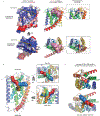


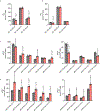

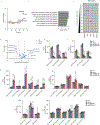

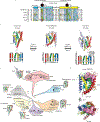
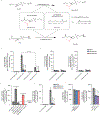
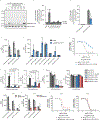

Similar articles
-
Plasticity of ether lipids promotes ferroptosis susceptibility and evasion.Nature. 2020 Sep;585(7826):603-608. doi: 10.1038/s41586-020-2732-8. Epub 2020 Sep 16. Nature. 2020. PMID: 32939090 Free PMC article.
-
Phospholipids with two polyunsaturated fatty acyl tails promote ferroptosis.Cell. 2024 Feb 29;187(5):1177-1190.e18. doi: 10.1016/j.cell.2024.01.030. Epub 2024 Feb 15. Cell. 2024. PMID: 38366593 Free PMC article.
-
Acyltransferases and transacylases involved in fatty acid remodeling of phospholipids and metabolism of bioactive lipids in mammalian cells.J Biochem. 1997 Jul;122(1):1-16. doi: 10.1093/oxfordjournals.jbchem.a021715. J Biochem. 1997. PMID: 9276665 Review.
-
Acyltransferases and transacylases that determine the fatty acid composition of glycerolipids and the metabolism of bioactive lipid mediators in mammalian cells and model organisms.Prog Lipid Res. 2014 Jan;53:18-81. doi: 10.1016/j.plipres.2013.10.001. Epub 2013 Oct 11. Prog Lipid Res. 2014. PMID: 24125941 Review.
-
Strikingly High Activity of 15-Lipoxygenase Towards Di-Polyunsaturated Arachidonoyl/Adrenoyl-Phosphatidylethanolamines Generates Peroxidation Signals of Ferroptotic Cell Death.Angew Chem Int Ed Engl. 2024 Feb 26;63(9):e202314710. doi: 10.1002/anie.202314710. Epub 2024 Jan 17. Angew Chem Int Ed Engl. 2024. PMID: 38230815 Free PMC article.
Cited by
-
Exploiting ferroptosis vulnerabilities in cancer.Nat Cell Biol. 2024 Sep;26(9):1407-1419. doi: 10.1038/s41556-024-01425-8. Epub 2024 Jun 10. Nat Cell Biol. 2024. PMID: 38858502 Review.
-
International consensus guidelines for the definition, detection, and interpretation of autophagy-dependent ferroptosis.Autophagy. 2024 Jun;20(6):1213-1246. doi: 10.1080/15548627.2024.2319901. Epub 2024 Mar 24. Autophagy. 2024. PMID: 38442890 Free PMC article. Review.
-
Alleviating symptoms of neurodegenerative disorders by astrocyte-specific overexpression of TMEM164 in mice.Nat Metab. 2023 Oct;5(10):1787-1802. doi: 10.1038/s42255-023-00887-8. Epub 2023 Sep 7. Nat Metab. 2023. PMID: 37679556
-
Transcriptomic and epigenomic landscapes of muscle growth during the postnatal period of broilers.J Anim Sci Biotechnol. 2024 Jul 4;15(1):91. doi: 10.1186/s40104-024-01049-w. J Anim Sci Biotechnol. 2024. PMID: 38961455 Free PMC article.
-
Lipoprotein N-terminal modification in Bacillus: a new paradigm for extracellular acetylation and species-dependent Toll-like receptor 2 immunomodulation.mBio. 2025 Aug 13;16(8):e0099625. doi: 10.1128/mbio.00996-25. Epub 2025 Jul 8. mBio. 2025. PMID: 40626731 Free PMC article.
References
-
- van Meer G, Voelker DR & Feigenson GW Membrane lipids: where they are and how they behave. Nat Rev Mol Cell Biol 9, 112–124 (2008). https://doi.org:10.1038/nrm2330 - DOI - PMC - PubMed
-
- Yang WS et al. Peroxidation of polyunsaturated fatty acids by lipoxygenases drives ferroptosis. Proc Natl Acad Sci U S A 113, E4966–4975 (2016). https://doi.org:10.1073/pnas.1603244113 - DOI - PMC - PubMed
-
- Stockwell BR et al. Ferroptosis: A Regulated Cell Death Nexus Linking Metabolism, Redox Biology, and Disease. Cell 171, 273–285 (2017). https://doi.org:10.1016/j.cell.2017.09.021 - DOI - PMC - PubMed
-
- Yang WS et al. Regulation of ferroptotic cancer cell death by GPX4. Cell 156, 317–331 (2014). https://doi.org:10.1016/j.cell.2013.12.010 - DOI - PMC - PubMed
-
- Eaton JK et al. Selective covalent targeting of GPX4 using masked nitrile-oxide electrophiles. Nat Chem Biol 16, 497–506 (2020). https://doi.org:10.1038/s41589-020-0501-5 - DOI - PMC - PubMed
Methods-only References
-
- Cajka T, Smilowitz JT & Fiehn O Validating Quantitative Untargeted Lipidomics Across Nine Liquid Chromatography-High-Resolution Mass Spectrometry Platforms. Anal Chem 89, 12360–12368 (2017). https://doi.org:10.1021/acs.analchem.7b03404 - DOI - PubMed
-
- Koch J et al. Unequivocal Mapping of Molecular Ether Lipid Species by LC-MS/MS in Plasmalogen-Deficient Mice. Anal Chem 92, 11268–11276 (2020). https://doi.org:10.1021/acs.analchem.0c01933 - DOI - PMC - PubMed
-
- Huang TP, Newby GA & Liu DR Precision genome editing using cytosine and adenine base editors in mammalian cells. Nat Protoc 16, 1089–1128 (2021). https://doi.org:10.1038/s41596-020-00450-9 - DOI - PubMed
-
- Clement K et al. CRISPResso2 provides accurate and rapid genome editing sequence analysis. Nat Biotechnol 37, 224–226 (2019). https://doi.org:10.1038/s41587-019-0032-3 - DOI - PMC - PubMed
Publication types
MeSH terms
Substances
Grants and funding
LinkOut - more resources
Full Text Sources
Molecular Biology Databases
Research Materials

